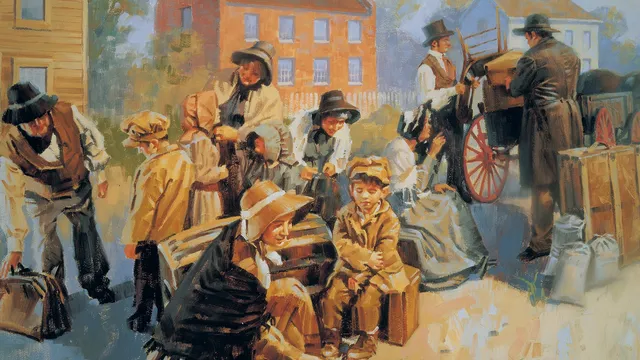
FAIR is a non-profit organization dedicated to providing well-documented answers to criticisms of the doctrine, practice, and history of The Church of Jesus Christ of Latter-day Saints.
FAIR › Scripture Study Resources: Supplement Your Come, Follow Me Study › Study Resources for the Doctrine & Covenants and Church History › Week 17 If Ye Are Not One Ye Are Not Mine
DOCTRINE AND COVENANTS 37 – 40

In Doctrine and Covenants 37:3–4, the Lord commanded the early Saints to leave their homes and gather in Ohio. This required faith and sacrifice, but it was ultimately for their benefit. Gathering helps us receive divine protection, learn truth, and strengthen each other in faith.
Doctrine and Covenants 38:31–33 teaches that when we follow the Lord’s call to gather—whether physically or spiritually—we are blessed beyond what we can initially see. Like the early Saints, we may not always understand the reasons for God’s direction, but trusting Him leads to greater unity and personal growth.
Doctrine and Covenants 38:30 teaches the principle that preparation eliminates fear. The early Saints faced significant uncertainty, yet the Lord assured them that their obedience and preparation would provide security. This principle applies today, reminding us that spiritual and physical preparedness bring confidence and peace.
Elder David A. Bednar, in his talk We Will Prove Them Herewith, emphasizes that preparation allows us to remain steadfast in trials. Being spiritually prepared through scripture study, prayer, and obedience strengthens our ability to face difficulties without fear. This preparation also includes making wise choices temporarily, such as saving for emergencies and caring for our health.
Elder Dale G. Renlund’s talk The Peace of Christ Abolishes Enmity teaches that through Christ’s example, we can remove contention from our hearts. When we follow Christ’s teachings, we see others as brothers and sisters rather than adversaries, allowing us to serve and support each other more fully.
The events in Doctrine and Covenants 37–40 take place in late 1830 and early 1831, a period of significant transition for the young Church. The Saints were primarily located in New York, but the Lord commanded them to gather in Ohio, marking the first major relocation of Church members.
If you have questions on this week’s reading, please email your questions to us here.
Practical solutions for someone in faith crisis:
Action Step: Identify an area in your life where God is prompting you to trust Him more, and take a step of faith.
The Saints were asked to leave their homes and move to an unfamiliar place. Though difficult, their obedience led to spiritual and temporal blessings. Trusting God in our own sacrifices strengthens our faith and brings unseen blessings.
Encouraging Thought:
Action Step: Reach out to someone in your ward, family, or community with kindness—especially someone you may not always connect with.
In Doctrine and Covenants 38:24–27, the Lord commanded the Saints to “be one” despite their differences. Unity allows us to grow spiritually, strengthen each other, and fulfill God’s purposes more effectively.
Encouraging Thought:
Doctrine and Covenants 38:30 teaches that “if ye are prepared ye shall not fear.” The Lord wants us to be both spiritually and physically prepared for the future, so we can face difficulties with faith rather than fear.
Encouraging Thought:
“When we are prepared, we can be calm and steadfast no matter what storms we face.” — Elder David A. Bednar
Objective: Help learners understand the faith required to follow God’s guidance, even when it requires sacrifice.
Paper, pens, a backpack with random items (to represent burdens or attachments), scriptures.
Activity Steps:
Follow-Up Question: What is one way you can show faith in God’s plan for your life this week?
Objective: Teach how unity strengthens us as a group, just as the Lord commanded in Doctrine and Covenants 38:24–27.
Colored paper squares, markers, tape or glue.
Follow-Up Question: What is one action you can take this week to bring more unity to your home, ward, or school?
Objective: Teach that preparation—spiritually and temporally—eliminates fear, as taught in Doctrine and Covenants 38:30.
A small survival kit (flashlight, food, water, first aid kit, etc.), scriptures.
Follow-Up Question: How does spiritual preparation help you handle life’s challenges with confidence?
Why Trust Modern Prophets?
Why Does God Allow Mistakes?

FAIR is a non-profit organization dedicated to providing well-documented answers to criticisms of the doctrine, practice, and history of The Church of Jesus Christ of Latter-day Saints.
We are a volunteer organization. We invite you to give back.
Donate Now